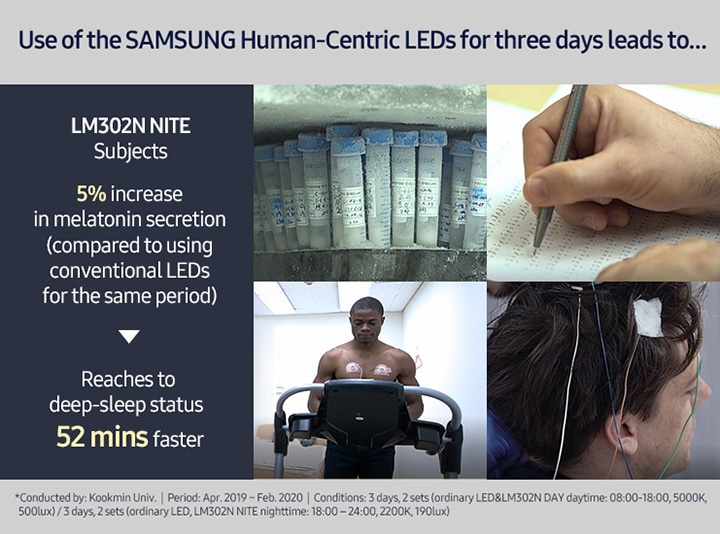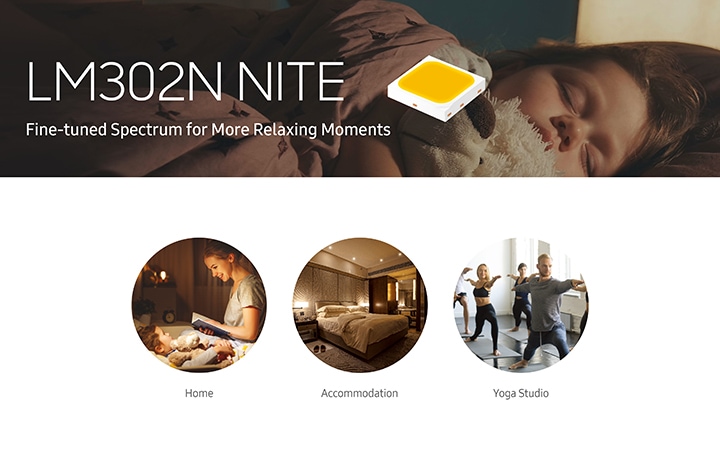Optimized Light for Circadian Rhythm Synchronization Enhancing Indoor Lifestyles

Spectrum engineering accurately realizes the functions of natural light, allowing users to maintain an optimal circadian rhythm. New developments discovered the melatonin spectrum that controls the melatonin hormone. The derived solution effectively managers melanopsin sensitivity at a wavelength of 480 nm, playing a critical role in circadian rhythm control for indoor lighting.
Introduction
We are spending most of our time indoors using artificial lighting. Melatonin, a hormone which regulates the sleep-wake cycle, responds to the cyan wavelength range of light. Brighter cyan-concentrated lighting suppresses the body’s production of melatonin, increasing concentration and enabling a greater overall sense of alertness. Similarly, a lower cyan light intensity minimizes disturbances to the natural onset of the body’s melatonin production, helping to promote sleep quality. Long exposure to bright light can confuse inbuilt natural circadian rhythms causing health problems such as insomnia.
Some studies, for example, shows that exposure to a spectrum with low power between 450-500 nm, but high power at even shorter wavelengths, did not suppress melatonin compared with dim light, despite a large difference in illuminance (175 lux vs. <5 lux). In contrast, exposure to the spectrum with high power between 450 and 500 nm (175 lux) resulted in almost 50% melatonin suppression [1].
Samsung’s LM302N NITE
Samsung Electronics unveiled its first “human-centric” LED packages, collectively known as LM302N. Engineered with carefully created light spectra, the LM302N family helps human bodies adjust melatonin levels indoors, making people feel more energetic or relaxed depending on their daily life patterns.
“The benefits of using Samsung’s LM302N reach beyond the basic lighting function of visual recognition, by improving the non-visual biological effects of lighting on people”, said Un Soo Kim, Senior Vice President of LED Business Team at Samsung Electronics.
“Our LED solutions are ushering in a whole new human-oriented approach of using artificial lighting to enhance productivity and relaxation, benefitting modern-day indoor lifestyles,” said Kim.
Samsung’s LM302N utilizes precisely designed light spectra with optimized amounts of cyan to accommodate lighting needs to the extent desired at any given point in time: The LM302N NITE enhances relaxation. Standardized at 3.0 x 3.0 mm, these offerings can fit in a wide range of lighting fixtures and are protected against humidity and heat.
The LM302N NITE can provide a proper level of melatonin, helping people to maintain the hormone level as if they were in a calm natural atmosphere at night. The body releases about five percent more melatonin under lights with the LM302N NITE packages than conventional LED packages, increasing relaxation. By comparison, spending a lot of time under conventional nighttime lighting can cause excessive alertness that makes it harder to fall asleep. Additionally, the LM302N NITE is offered in color temperatures between 1800 K and 4000 K, providing design flexibility to bring the benefits of relaxing light to a variety of lighting spaces.
Clinical tests showed 18% more surpressed melatonin during the day, 5% more secreted melatonin at night, 3% more increased concentration, and 52 minutes earlier deep sleep compared with conventional LED lighting.

The newly launched LM302N family is now in mass production.
References
[1] Souman, Jan & Borra, Tobias & Goijer, Iris & Schlangen, Luc & Vlaskamp, Björn & Lucassen, Marcel. (2018). Spectral Tuning of White Light Allows for Strong Reduction in Melatonin Suppression without Changing Illumination Level or Color Temperature. Journal of Biological Rhythms. 33.
For more information: https://led.samsung.com/lighting/mid-power-leds/3030-leds/lm302n-nite/


Figure 1: LM302N NITE – Lighting to relax: New LED packages help improve the quality of sleep by adjusting melatonin levels
| Product | CRI* | CCT (K)** | M/P Ratio*** | MDER**** | Size |
|---|---|---|---|---|---|
| LM302N NITE | 80+ | 1800 | 0.20 | 0.18 | 3.0×3.0 mm |
| 2200 | 0.28 | 0.25 | |||
| 2700 | 0.37 | 0.34 | |||
| 3000 | 0.48 | 0.43 | |||
| 3500 | 0.56 | 0.51 | |||
| 4000 | 0.64 | 0.58 |
Table 1: * M/P Ratio (Melanopic/photopic ration): measure of how efficiently a light source triggers suppression of melatonin.** MDER (Melanopic daylight efficacy ration): a measure of how bright standard light (Illuminant D65, defined by International Commission on Illumination) should be for a level of melatonin suppression comparable to the tested light source.
LED professional Review, "Optimized Light for Circadian Rhythm Synchronization Enhancing Indoor Lifestyle"


 Copyright ⓒ 1995-2023 SAMSUNG All Rights reserved.
Copyright ⓒ 1995-2023 SAMSUNG All Rights reserved.